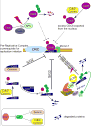Mechanisms to control rereplication and implications for cancer
- PMID: 18053699
- PMCID: PMC2174913
- DOI: 10.1016/j.ceb.2007.10.007
Mechanisms to control rereplication and implications for cancer
Abstract
Recent advances in the replication field have highlighted how the replication initiator proteins are negatively regulated by inhibitor proteins and ubiquitin-mediated degradation in mammalian cells to prevent rereplication. When these regulatory pathways go awry, uncontrolled rereplication ensues and a G2/M checkpoint is evoked to prevent cellular death. Many components of the checkpoints activated by rereplicaton are important for cancer prevention by facilitating DNA damage repair processes. The pathways that prevent rereplication themselves have also recently been implicated in preventing tumorigenesis. Studies from patient tumors, genetically altered mice, and mammalian cell culture suggest that deregulation of replication licensing proteins results in an increase in aneuploidy, chromosomal fusions, and DNA breaks. These studies provide a framework to address how regulators of replication function to maintain genomic stability.
Figures


References
-
- Bell SP, Dutta A. DNA replication in eukaryotic cells. Annu Rev Biochem. 2002;71:333–374. - PubMed
-
- Lei M, Tye BK. Initiating DNA synthesis: from recruiting to activating the MCM complex. J Cell Sci. 2001;114:1447–1454. - PubMed
-
- Randell JC, Bowers JL, Rodriguez HK, Bell SP. Sequential ATP hydrolysis by Cdc6 and ORC directs loading of the Mcm2-7 helicase. Mol Cell. 2006;21:29–39. - PubMed
-
- Machida YJ, Hamlin JL, Dutta A. Right place, right time, and only once: replication initiation in metazoans. Cell. 2005;123:13–24. - PubMed
-
- Arias EE, Walter JC. Strength in numbers: preventing rereplication via multiple mechanisms in eukaryotic cells. Genes Dev. 2007;21:497–518. - PubMed
Publication types
MeSH terms
Substances
Grants and funding
LinkOut - more resources
Full Text Sources
Other Literature Sources

